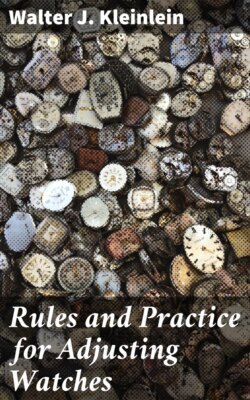Читать книгу Rules and Practice for Adjusting Watches - Walter J. Kleinlein - Страница 13
На сайте Литреса книга снята с продажи.
5.Effect of Shifting Screws to Different Locations.
ОглавлениеAs a rule compensation balances generally have five or six pairs of balance screws in addition to two pairs of mean time screws. High grade Swiss and some American models do not have mean time screws and are therefore generally supplied with seven or eight pairs of balance screws. The mean time screws are never disturbed in making alterations for temperature, such alterations being confined to the balance screws only and the mean time screws are reserved for timing.
For appearance sake the balance screws should be evenly distributed, although it is necessary at times to closely assemble them to obtain temperature results and they should not be disturbed in making ordinary repairs, as the adjustment may be destroyed in so doing. With the larger balances the moving of one pair of screws for a distance of one hole, generally makes a difference of four or five seconds in the temperature rate. In the case of smaller balances this alteration does not make as much difference, although the weight and location of the screws has considerable influence on the result.
A pair of screws shifted from the second holes from the cuts, to the holes adjoining the cuts, will generally make a correction four or five times as great as would be obtained by shifting a pair of screws from the third to the fourth holes from the arms. The same proportional difference is obtained in moving a pair of screws from the center of the rims out to the cut, compared to moving a pair of screws from the holes nearest the arms out to the center of the rims. This principle also obtains in moving the screws in the opposite direction and is due to the fact that while the metals composing the balance follow the common laws of expansion and contraction, the balance actually becomes smaller in area during expansion and larger during contraction. This condition is made possible entirely through joining the metals in proper proportion and then cutting the rims.
In the factories where large quantities of a particular model having a standard style balance are handled, tests are usually made to determine as to just what degree of correction will be obtained by shifting various pairs of screws certain distances. This information is then used in making alterations with considerable certainty. The expert temperature adjuster becomes fully informed as to the peculiarities of various models and is capable of getting larger percentages of watches within the limits of allowance, after making alterations, than he could obtain otherwise.
Through understanding the various models individually, he is also enabled to furnish information that will cause intelligent arrangement of the balance screws, for each model, when they are originally fitted. The production thereby showing a greater yield of good watches that do not require alterations after the first test.
